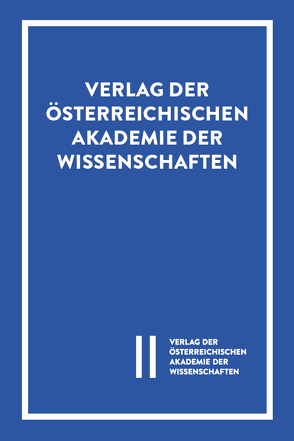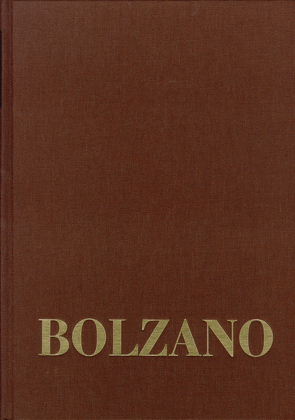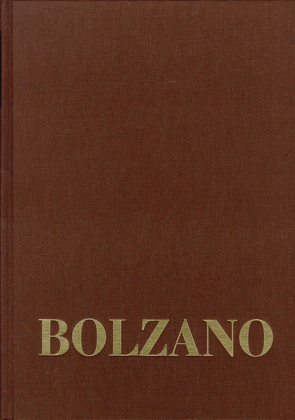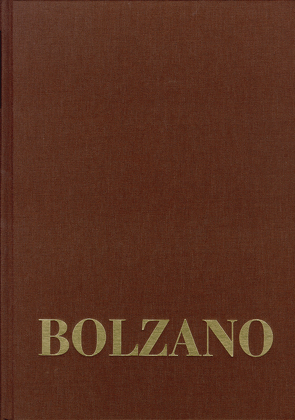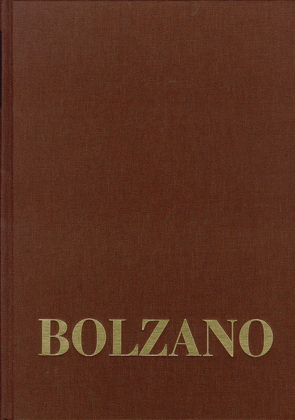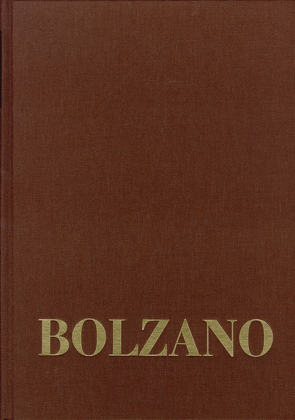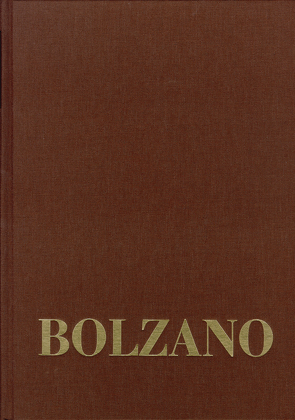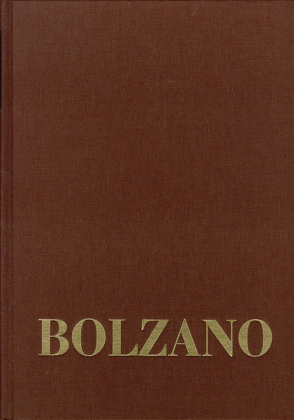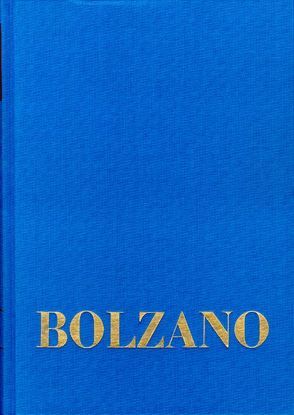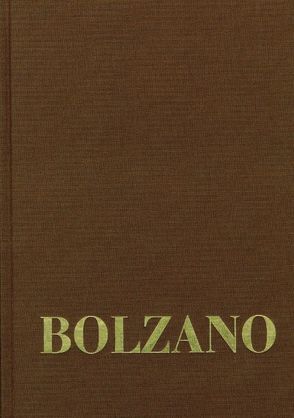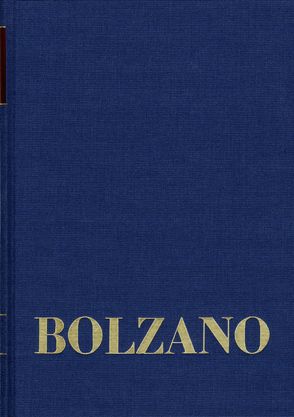
The notes of part 22 of the ‹Miscellanea Mathematica‹ were written between July of 1830 and August of 1832. Bolzano‹s natural philosophy of his later years was based on the assumption that the entire universe had a nuclear particle structure. Unlike the classic atomist, he believed that there was an atom at every point in space. Thus there is no vacuum. This means that no substance is isolated. This made him question the opposite view which he had expressed previously in the ‹Athanasia‹. His refutation in the second edition of the ‹Athanasia‹ is given in detail in the ‹Miscellanea Mathematica‹. At the beginning of the ‹Miscellanea Mathematica 22‹, he dealt with the definition of the concepts of space and time. According to Bolzano, the traditional definitions of the concepts of line, surface and solid were in need of improvement, and this induced him to give a detailed explanation. During the years of his reclusiveness after his dismissal in 1819 from his position as head of the department for religious studies at the University of Prague, Bolzano had been studying the logical foundations of mathematics and the foundations of logic. These studies were reflected in his theory of science. When he returned to pure mathematics after about a decade, he began work on a new encyclopedic work, the ‹Größenlehre‹, (Theory of Quantities). The notes in this volume contain a precisely structured plan of this work from the year 1831. In explaining the first arithmetical terms, Bolzano tries to avoid abstract terms. Some abstract terms are imaginary. Referring to contemporary scientific journals, he gives a report on imaginary and irrational quantities in the theory of numbers. On the basis of Legendre‹s discussion of Galois‹ problem of the solvability of algebraic equations, Bolzano suggests a simple method. He gives a detailed account of Gergonne‹s geometric treatment of Newton‹s method of finding the roots of a numerical equation by approximation and provides a counterexample for Fourier‹s assertion that a characteristic of the existence of the real roots of an equation also applies to transcendental roots. Furthermore he tries to find a simpler formulation of Cauchy‹s proof that each polynomial has a complex root. Bolzano studies the proof provided by several famous analytic theorems. He mentions Cauchy‹s simple and strict proof of Taylor‹s theorem and Crelle‹s attempt to expand this within the context of general theory of analytic functions. He studies Cauchy‹s theory of the infinite, examines several theorems and works his way around to the theory of tangency and discusses infinite series. There are no infinite large and small numbers, these terms are meaningless. The pivotal concepts of continuity and continuous functions are dealt with in several places. What is particularly remarkable is the discussion of the determinability of the functions. There was deemed to be a discrepancy between Bolzano‹s theory of functions and his paradoxes of the infinite. One way to eliminate this discrepancy would be to find an exact definition of the concept of determinability. A continuous function f is exactly determinable when the difference (x+∆x) –f(x) retains the same sign within certain values of x irregardless of how close they may be. Thus a determinable function is a continuous, piecewise monotonic function.
Aktualisiert: 2023-05-25
> findR *
Aktualisiert: 2023-05-12
> findR *
Der fünfte und letzte Teilband von Bolzanos Briefen an Fesl umfasst 82 Schreiben aus den Jahren 1846 bis 1848, in denen er trotz seiner schlechten Gesundheit neue Projekte angeht, von denen die Schriften über soziale Fragen – nicht zuletzt ›Über die Wohlthätigkeit‹ (1847) – noch zu seinen Lebzeiten erscheinen, andere hingegen erst postum, darunter das ›Kurzgefaßte Lehrbuch der katholisch-christlichen Religion‹ (1849), der Aufsatz ›Ueber die Eintheilung der schönen Künste‹ (1849), ›Drei philosophische Abhandlungen […]‹ (1851) und die ›Paradoxien des Unendlichen‹ (1851). In seinem letzten Lebensjahr nimmt Bolzano zudem klar Stellung zu den als »bürgerliche Revolution« bekannten politischen Vorgängen.
Aktualisiert: 2023-05-11
> findR *
Der fünfte und letzte Teilband von Bolzanos Briefen an Fesl umfasst 82 Schreiben aus den Jahren 1846 bis 1848, in denen er trotz seiner schlechten Gesundheit neue Projekte angeht, von denen die Schriften über soziale Fragen – nicht zuletzt ›Über die Wohlthätigkeit‹ (1847) – noch zu seinen Lebzeiten erscheinen, andere hingegen erst postum, darunter das ›Kurzgefaßte Lehrbuch der katholisch-christlichen Religion‹ (1849), der Aufsatz ›Ueber die Eintheilung der schönen Künste‹ (1849), ›Drei philosophische Abhandlungen […]‹ (1851) und die ›Paradoxien des Unendlichen‹ (1851). In seinem letzten Lebensjahr nimmt Bolzano zudem klar Stellung zu den als »bürgerliche Revolution« bekannten politischen Vorgängen.
Aktualisiert: 2023-05-04
> findR *
Der fünfte und letzte Teilband von Bolzanos Briefen an Fesl umfasst 82 Schreiben aus den Jahren 1846 bis 1848, in denen er trotz seiner schlechten Gesundheit neue Projekte angeht, von denen die Schriften über soziale Fragen – nicht zuletzt ›Über die Wohlthätigkeit‹ (1847) – noch zu seinen Lebzeiten erscheinen, andere hingegen erst postum, darunter das ›Kurzgefaßte Lehrbuch der katholisch-christlichen Religion‹ (1849), der Aufsatz ›Ueber die Eintheilung der schönen Künste‹ (1849), ›Drei philosophische Abhandlungen […]‹ (1851) und die ›Paradoxien des Unendlichen‹ (1851). In seinem letzten Lebensjahr nimmt Bolzano zudem klar Stellung zu den als »bürgerliche Revolution« bekannten politischen Vorgängen.
Aktualisiert: 2023-05-04
> findR *
Der vierte Teilband von Bolzanos Briefen an Fesl umfasst 89 Schreiben aus den Jahren 1841 bis 1845, die eine Zeit der Krisen dokumentieren: Vor allem verschlechtert sich der Gesundheitszustand von Bolzanos »Lebenserhalterin« Anna Hoffmann, bis sie am 20. April 1842 in seinem Beisein stirbt. Am Ende dieses Jahres stirbt zudem Vinzenz Fiebrich, der sich in Wien als Polizeikommissär diskret zu Bolzanos Gunsten einsetzte. Dies wirkt sich nicht nur auf Bolzanos Schaffenskraft aus, sondern auch auf seine Beziehung zu Fesl, der seinerseits in der Folge kaum mehr für Bolzano tätig ist. Dennoch gelten die Briefe auch wichtigen Projekten dieser Jahre, so der ›Beurteilenden Übersicht‹ von ›Wissenschaftslehre‹ und ›Religionswissenschaft‹ (1841) und der ›Perfectibilität des Katholicismus‹ (1845) sowie den ästhetischen Themen, denen sich Bolzano nun zuwendet.
Aktualisiert: 2023-02-09
> findR *
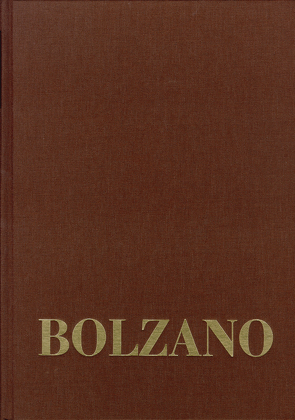
Mit dem Band 5,2 findet die Briefwechsel-Reihe III der Bolzano-Gesamtausgabe ihren Abschluß. Der Band bietet daher, was Bolzanos Briefpartner, aber auch die behandelten Themen betrifft, ein weniger einheitliches Bild als frühere Bände der Reihe. Bolzanos liebevoller Umgang mit Kindern und Jugendlichen zeigt sich in den Briefen an die Enkelin von Anna Hoffmann und an die kränkliche Rosalie von Neupauer. Die angespannte familiäre Atmosphäre in Bolzanos Elternhaus wird in den Briefen von und an Bolzanos Bruder Peter beleuchtet. Die fünf Briefe an Eduard von Badenfeld bieten Bolzano Gelegenheit, Fragen zu Themen der Ästhetik, Ethik und Metaphysik anzuschneiden. Von besonderer wissenschaftlicher Bedeutung ist ein Brief von Anton Slivka von Sliwitz mit vielen Formeln aus der Wahrscheinlichkeitstheorie; darin geht es um die Frage, welchen Zuverlässigkeitsgrad von Zeugen bestätigte historische Aussagen (für Bolzano besonders wichtig: Wunderberichte) erreichen können. So bietet dieser abschließende Band der Briefwechsel-Reihe neben wichtigen Ergänzungen zu Bolzanos Biographie auch einige Klarstellungen zu seinem wissenschaftlichen Werk.
Aktualisiert: 2022-08-18
> findR *
Der dritte Teilband von Bolzanos Briefen an Fesl ist mit 99 Briefen der umfangreichste (wobei etwa 20 Schreiben aus dem Jahr 1838 sogar verloren gegangen sind). Die Intensität der Korrespondenz in den Jahren 1837 bis 1840 hat in erster Linie mit den von Fesl betreuten Buchprojekten zu tun: In diesem Zeitraum erschienen nämlich neben der ›Wissenschaftslehre‹ noch vier weitere Bücher Bolzanos sowie die Neuauflagen der ›Athanasia‹ und der ›Erbauungsreden‹. Bolzanos Briefe dokumentieren die Vorbereitung dieser Publikationen ebenso wie deren Rezeption und die Arbeit an weiteren Publikationsprojekten (die zum Teil nie verwirklicht worden sind). Auch das einzige Treffen der beiden Freunde nach ihrer Verurteilung, das im September 1838 in Těchobuz zustande kam, findet seinen Niederschlag in den Briefen, nicht zuletzt mit Bezug auf die dort besprochenen wissenschaftlichen Vorhaben.
Aktualisiert: 2022-08-18
> findR *

In diesem Band werden Bolzanos ästhetische Abhandlungen ›Arten des Schönen‹ und ›Verschiedene in die Ästhetik gehörige Begriffe‹, deren Handschriften im Prager Bolzano-Nachlass aufbewahrt werden, erstmals veröffentlicht. Außerdem enthält der Band eine kritische Neuausgabe der Schrift ›Über die Eintheilung der schönen Künste‹, die Bolzano zwar noch selbst in der Königlich böhmischen Gesellschaft der Wissenschaften vorgetragen hat, die jedoch erst nach seinem Tod in den Akten der Gesellschaft erschien. In einem Anhang werden alle weiteren im Prager Bolzano-Nachlass aufbewahrten Handschriften zu ästhetischen Themen genau beschrieben, von denen fünf für eine Veröffentlichung in Frage kommen. Sie werden in diesem Band erstmals kritisch ediert; darin geht es um Fragen der Poetik, um weitere Begriffe, die nach Bolzano in die Ästhetik gehören, und um eine Kritik an Goethes ›Wilhelm Meister‹. Ein zweiter Anhang bietet eine chronologische Übersicht über Bolzanos Beschäftigung mit ästhetischen Fragen in seinen veröffentlichten Schriften, Tage- und Notizbüchern, Erbauungsreden und Briefen; ergänzt wird dieser zweite Anhang durch ein Verzeichnis der Primär- und Sekundärliteratur zu Bolzanos Ästhetik. Damit ist nun die Grundlage für eine Gesamtbeurteilung und abschließende Würdigung von Bolzanos Ästhetik geschaffen.
Aktualisiert: 2023-03-14
> findR *
The first volume contains the correspondence between Bolzano and his student and friend M. J. Fesl between 1815 and 1827. Their letters deal mainly with the legal action taken by the church and the state against Fesl and Bolzano. Thus this volume is an important historical source for the so-called Bolzano trial. The correspondence between Bolzano and Fesl during the following years (1828–1848) deals with various subjects and gives important biographical information about Bolzano and Fesl. Furthermore there are some letters written by Bolzano to Fesl which are relevant from a philosophical perspective, in particular in view of Bolzano’s theories on aesthetics.
Aktualisiert: 2022-08-18
> findR *
The volume I,1-3 contains 19 letters written by Bolzano to his mother and 542 letters to his brother Johann. The last letter is dated September 7, 1848. Many of the letters deal with ordering and borrowing books and in addition with running everyday errands. Bolzano obviously did not discuss academic subjects with his mother and his brother. These letters do however constitute a significant documentation of his everyday life and his travels and are eloquent evidence of the way he dealt with his brother Johann and the affection with which he treated his mother.
Aktualisiert: 2022-08-18
> findR *
The volume I, 1-3 contains 19 letters written by Bolzano to his mother and 542 letters to his brother Johann. The last letter is dated September 7, 1848. Many of the letters deal with ordering and borrowing books and in addition with running everyday errands. Bolzano obviously did not discuss academic subjects with his mother and his brother. These letters do however constitute a significant documentation of his everyday life and his travels and are eloquent evidence of the way he dealt with his brother Johann and the affection with which he treated his mother.
Aktualisiert: 2022-08-18
> findR *
The volume I, 1-3 contains 19 letters written by Bolzano to his mother and 542 letters to his brother Johann. The last letter is dated September 7, 1848. Many of the letters deal with ordering and borrowing books and in addition with running everyday errands. Bolzano obviously did not discuss academic subjects with his mother and his brother. These letters do however constitute a significant documentation of his everyday life and his travels and are eloquent evidence of the way he dealt with his brother Johann and the affection with which he treated his mother.
Aktualisiert: 2022-08-18
> findR *
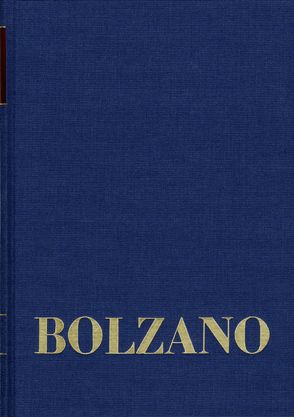
The notes of part 22 of the ‹Miscellanea Mathematica‹ were written between July of 1830 and August of 1832. Bolzano‹s natural philosophy of his later years was based on the assumption that the entire universe had a nuclear particle structure. Unlike the classic atomist, he believed that there was an atom at every point in space. Thus there is no vacuum. This means that no substance is isolated. This made him question the opposite view which he had expressed previously in the ‹Athanasia‹. His refutation in the second edition of the ‹Athanasia‹ is given in detail in the ‹Miscellanea Mathematica‹. At the beginning of the ‹Miscellanea Mathematica 22‹, he dealt with the definition of the concepts of space and time. According to Bolzano, the traditional definitions of the concepts of line, surface and solid were in need of improvement, and this induced him to give a detailed explanation. During the years of his reclusiveness after his dismissal in 1819 from his position as head of the department for religious studies at the University of Prague, Bolzano had been studying the logical foundations of mathematics and the foundations of logic. These studies were reflected in his theory of science. When he returned to pure mathematics after about a decade, he began work on a new encyclopedic work, the ‹Größenlehre‹, (Theory of Quantities). The notes in this volume contain a precisely structured plan of this work from the year 1831. In explaining the first arithmetical terms, Bolzano tries to avoid abstract terms. Some abstract terms are imaginary. Referring to contemporary scientific journals, he gives a report on imaginary and irrational quantities in the theory of numbers. On the basis of Legendre‹s discussion of Galois‹ problem of the solvability of algebraic equations, Bolzano suggests a simple method. He gives a detailed account of Gergonne‹s geometric treatment of Newton‹s method of finding the roots of a numerical equation by approximation and provides a counterexample for Fourier‹s assertion that a characteristic of the existence of the real roots of an equation also applies to transcendental roots. Furthermore he tries to find a simpler formulation of Cauchy‹s proof that each polynomial has a complex root. Bolzano studies the proof provided by several famous analytic theorems. He mentions Cauchy‹s simple and strict proof of Taylor‹s theorem and Crelle‹s attempt to expand this within the context of general theory of analytic functions. He studies Cauchy‹s theory of the infinite, examines several theorems and works his way around to the theory of tangency and discusses infinite series. There are no infinite large and small numbers, these terms are meaningless. The pivotal concepts of continuity and continuous functions are dealt with in several places. What is particularly remarkable is the discussion of the determinability of the functions. There was deemed to be a discrepancy between Bolzano‹s theory of functions and his paradoxes of the infinite. One way to eliminate this discrepancy would be to find an exact definition of the concept of determinability. A continuous function f is exactly determinable when the difference (x+∆x) –f(x) retains the same sign within certain values of x irregardless of how close they may be. Thus a determinable function is a continuous, piecewise monotonic function.
Aktualisiert: 2022-11-10
> findR *
Bernard Bolzano’s work as a scholar and scientist was guided by the idea that all the truths of all fields of knowledge constitute an objective order given independently of our thinking and knowledge. This holds also for the truths of the various areas of philosophy such as logic and epistemology, metaphysics and philosophy of religion, ethics and political philosophy. It is the task of philosophy to discover these truths and their order. The result of this endeavour is the system of philosophy: it unites all the philosophical truths in a strict logical order. This system of philosophy is completely different from all the complacent »philosophical systems« from which Bolzano repeatedly disassociated himself. In his book Edgar Morscher presents a reconstruction of Bernard Bolzano’s system of philosophy in accord with the latest developments of Bolzano research and uses all sources now available through the Bernard-Bolzano-Gesamtausgabe.
Aktualisiert: 2022-06-30
> findR *
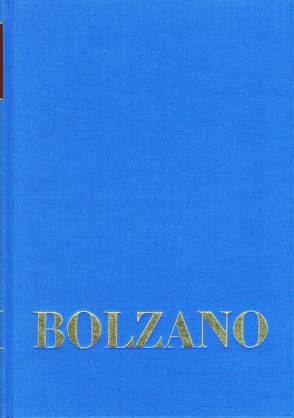
The ›Betrachtungen über einige Gegenstände der Elementargeometrie‹ marks the beginning of a life-long programme devoted to the re-organisation of geometry, and mathematics in general, according to Bolzano‹s own far-reaching methodological principles. Rejecting the concepts of motion, and of the plane, in the first part he proposes proofs of the »die ersten Lehrsätze von Dreiecken und Parallellinien« based only on his radical, and largely original second part: »einer künftig aufzustellenden Theorie der geraden Linie«. The first main part of the ›Beyträge zu einer begründeteren Darstellung der Mathematik‹ is devoted to the nature of mathematics and its proper classification. There is an unusually abstract definition of mathematics as »eine Wissenschaft … die von den allgemeinen Gesetzten (Formen) handelt, nach welchen sich diese Dinge in ihrem Daseyn richten« (I, §.8). The second part develops the methodological principles introduced in the ›Betrachtungen‹ in greater detail and introduces Bolzano‹s idea that, »in dem Inbegriffe aller wahren Urtheile herrscht ein gewisser Objectiver, von unserer zufälligen Subjectiven Anerkennung derselben unabhängiger Zusammenhang.« (II, §. 2) This relation [Abfolge] was to become an important theme of his famous later work 'Wissenschaftslehre! (1837). An Appendix criticises Kant‹s theory of the construction of mathematical concepts through pure intuition.
Aktualisiert: 2022-08-18
> findR *
This volume, published in 1813, contains the first selection of edification speeches which Bolzano had held up to that time as a professor of Catholic religious education at the University of Prague. In these speeches, Bolzano advocated pacifist and socialist ideas and called for a humane constitution which guaranteed fundamental human rights. This led to his instant dismissal in the winter semester of 1819/20. In 1828 this edition of the ›Erbauungsreden‹ (edification speeches) was put on the index of prohibited books.
Aktualisiert: 2022-08-18
> findR *
Bolzano‹s letters to his former student Josef Sommer are, apart from the letters to Michael Josef Fesl und František Příhonský, the third largest collection of letters in Bolzano‹s literary estate. The letters to Sommer show the progress of his work on the ‹Wissenschaftslehre‹ (Theory of Science) and the ‹Größenlehre‹ (Theory of Quantities), among other things. This volume also contains letters to the mathematician Johann Friedrich Christian Werneburg, to his former students Florian Werner, Václav Alois Svoboda and Johann August Zimmermann as well as to the educators Franz Carl Hillardt and his friends Antonín Karel Přibyl, Jan Pospíšil and Franz Pistl.
Aktualisiert: 2023-03-14
> findR *
INHALT: a. Editionsprinzipien der Bernard Bolzano-Gesamtausgabe - b. Katalog des Bolzano-Nachlasses in der Österreichischen Nationalbibliothek von JAN BERG: (I) Katalog des Nachlasses (der Wiener Bolzano-Nachlass enthält Manuskripte mathematischen Inhaltes sowie Briefe), (II) Personenverzeichnis - c. Bolzano-Bibliographie von JAN BERG, EDGAR MORSCHER und MARIE PAVLÍKOVÁ: (I) Bolzanos veröffentlichte Schriften, (II) Literatur über Bolzano, (III) Chronologisches Register, (IV) Übersicht nach Sachgebieten (Stand 1971) - ANHANG: Gliederung der Bernard Bolzano-Gesamtausgabe.
Aktualisiert: 2022-08-18
> findR *
These three volumes from the set provide the complete edition of the 261 letters still in existence written by Bolzano between 1824 and 1848 to his most important student František Příhonský. Annotations, a bibliography and indexes have been added to these. These letters reflect many aspects of Bolzano‹s personal circumstances and shed light on the relationships to his circle of friends. They also provide information about his work as a writer in the last decades of his life. It was during this time that he wrote most of his scientific works.
Aktualisiert: 2023-03-14
> findR *
MEHR ANZEIGEN
Bücher von Louzil, Jaromír
Sie suchen ein Buch oder Publikation vonLouzil, Jaromír ? Bei Buch findr finden Sie alle Bücher Louzil, Jaromír.
Entdecken Sie neue Bücher oder Klassiker für Sie selbst oder zum Verschenken. Buch findr hat zahlreiche Bücher
von Louzil, Jaromír im Sortiment. Nehmen Sie sich Zeit zum Stöbern und finden Sie das passende Buch oder die
Publiketion für Ihr Lesevergnügen oder Ihr Interessensgebiet. Stöbern Sie durch unser Angebot und finden Sie aus
unserer großen Auswahl das Buch, das Ihnen zusagt. Bei Buch findr finden Sie Romane, Ratgeber, wissenschaftliche und
populärwissenschaftliche Bücher uvm. Bestellen Sie Ihr Buch zu Ihrem Thema einfach online und lassen Sie es sich
bequem nach Hause schicken. Wir wünschen Ihnen schöne und entspannte Lesemomente mit Ihrem Buch
von Louzil, Jaromír .
Louzil, Jaromír - Große Auswahl an Publikationen bei Buch findr
Bei uns finden Sie Bücher aller beliebter Autoren, Neuerscheinungen, Bestseller genauso wie alte Schätze. Bücher
von Louzil, Jaromír die Ihre Fantasie anregen und Bücher, die Sie weiterbilden und Ihnen wissenschaftliche Fakten
vermitteln. Ganz nach Ihrem Geschmack ist das passende Buch für Sie dabei. Finden Sie eine große Auswahl Bücher
verschiedenster Genres, Verlage, Schlagworte Genre bei Buchfindr:
Unser Repertoire umfasst Bücher von
- Löv, Mira
- Loval, Werner M.
- Lovano, Joe
- Lovas, Kati
- Lovász, László
- Lovász, Stephanie
- Lovat, Daniel
- Lovatelli, Ginevra
- Lovato, Antonio
- Lovato, Demi
Sie haben viele Möglichkeiten bei Buch findr die passenden Bücher für Ihr Lesevergnügen zu entdecken. Nutzen Sie
unsere Suchfunktionen, um zu stöbern und für Sie interessante Bücher in den unterschiedlichen Genres und Kategorien
zu finden. Neben Büchern von Louzil, Jaromír und Büchern aus verschiedenen Kategorien finden Sie schnell und
einfach auch eine Auflistung thematisch passender Publikationen. Probieren Sie es aus, legen Sie jetzt los! Ihrem
Lesevergnügen steht nichts im Wege. Nutzen Sie die Vorteile Ihre Bücher online zu kaufen und bekommen Sie die
bestellten Bücher schnell und bequem zugestellt. Nehmen Sie sich die Zeit, online die Bücher Ihrer Wahl anzulesen,
Buchempfehlungen und Rezensionen zu studieren, Informationen zu Autoren zu lesen. Viel Spaß beim Lesen wünscht Ihnen
das Team von Buchfindr.

